上海牛津小学英语语法知识总结
语法知识点汇总(知识清单)牛津上海版(试用本)英语六年级下册
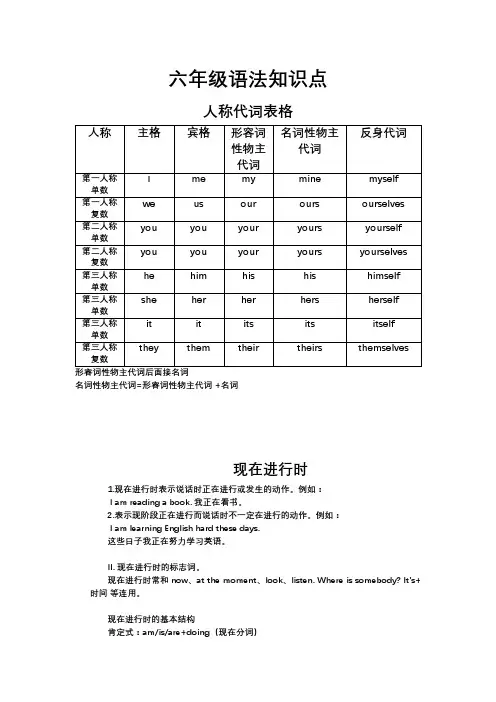
六年级语法知识点人称代词表格名词性物主代词=形容词性物主代词 +名词现在进行时1.现在进行时表示说话时正在进行或发生的动作。
例如:I am reading a book. 我正在看书。
2.表示现阶段正在进行而说话时不一定在进行的动作。
例如:I am learning English hard these days.这些日子我正在努力学习英语。
II. 现在进行时的标志词。
现在进行时常和now、at the moment、look、listen. Where is somebody? It’s+时间 等连用。
现在进行时的基本结构肯定式:am/is/are+doing(现在分词)They’re having a meeting now. 他们现在正在开会。
否定式:am/is/are not +doing(现在分词)They aren\'t having a meeting now. 他们现在没有在开会。
一般疑问式:Am/Is/Are + 主语 +doing(现在分词)+ 其他Are they having a meeting now? 他们现在正在开会吗?特殊疑问式:特殊疑问词+一般疑问式What are they doing now? 他们现在正在做什么?现在分词(doing)的变化规则1. 一般情况下,在动词词尾加ing。
go——goingplay——playingknow——knowing2. 以不发音的字母e结尾动词,先去e再加ing。
make——makingarrive——arrivinge——ing3. 以重读闭音节结尾,且动词词尾只有一个辅音字母时,先双写这个辅音字母,再加ing。
run——runningstop——stoppingswim——swimmingrun——runningput——puttingsit——sittingbegin——beginningplan——planningcut——cuttingget——gettingshop——shoppingchat——chattingregret——regrettingdig——digging4. 以ie结尾,先将ie改成y,再加ing。
(完整版)上海牛津小学英语语法知识总结
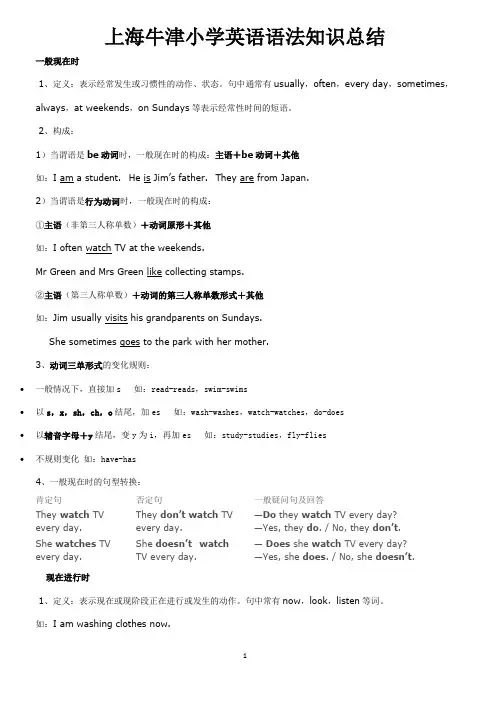
上海牛津小学英语语法知识总结一般现在时1、定义:表示经常发生或习惯性的动作、状态。
句中通常有usually,often,every day,sometimes,always,at weekends,on Sundays等表示经常性时间的短语。
2、构成:1)当谓语是be动词时,一般现在时的构成:主语+be动词+其他如:I am a student. He is Jim’s father.They are from Japan.2)当谓语是行为动词时,一般现在时的构成:①主语(非第三人称单数)+动词原形+其他如:I often watch TV at the weekends.Mr Green and Mrs Green like collecting stamps.②主语(第三人称单数)+动词的第三人称单数形式+其他如:Jim usually visits his grandparents on Sundays.She sometimes goes to the park with her mother.3、动词三单形式的变化规则:•一般情况下,直接加s 如:read-reads,swim-swims•以s,x,sh,ch,o结尾,加es 如:wash-washes,watch-watches,do-does•以辅音字母+y结尾,变y为i,再加es 如:study-studies,fly-flies•不规则变化如:have-has4、一般现在时的句型转换:肯定句否定句一般疑问句及回答They watch TV every day. They don’t watch TVevery day.—Do they watch TV every day?—Yes, they do. / No, they don’t.She watches TV every day. She doesn’t watchTV every day.—Does she watch TV every day?—Yes, she does. / No, she doesn’t.现在进行时1、定义:表示现在或现阶段正在进行或发生的动作。
“牛津上海版”小学英语二年级(上)知识点大全
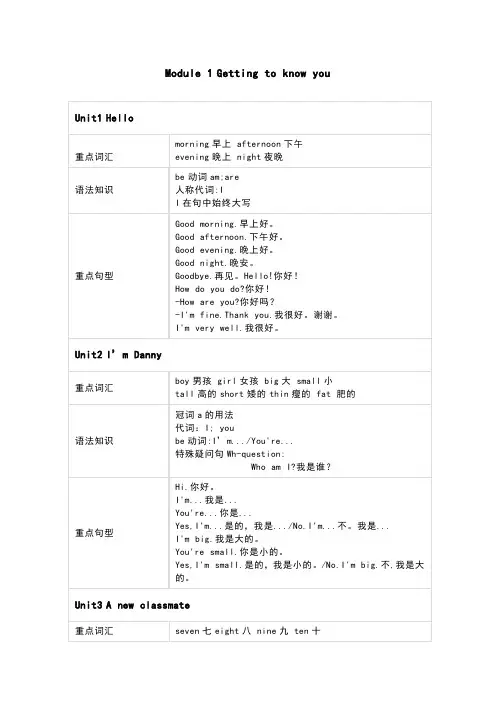
Unit2 That's my family
重点词汇 语法知识 重点句子
young 年轻的 old 老的 kind 体贴的 nice 友好的 sweet 惹人喜爱的 jar 罐子 t 昆虫
人称代词:she,he 物主代词:my,your 一般疑问:Is he/she...?
Yes,he/she is. No,he/she isn't. be 动词:He/She is... 特殊疑问句:Wh-question:
可数名词-复数 介词:in.on,under 特殊疑问句:How many...? There be 句型:There is/are... 祈使句:Give me...,please.
No,thanks.不需要,谢谢。 Yes,please.是的,请给我。 Here you are.给你。 Dinner is ready.晚餐准备好了。 I'm coming.我来了。 Give me a plate,please.请给我一个盘子。 How many bowls?多少碗? There are four bowls.有 4 个碗。 How many spoons?多少勺子? There is one.有一个勺子。 There is a table and a chair in the room.房间里 有一张桌子和一把椅子。 There are two bowls on the table.桌子上有两个碗。 Ginger is under the chair.生姜在椅子下面。 He's sitting under the chair.他在椅子下面坐着。
Unit3 A new classmate
重点词汇
seven 七 eight 八 nine 九 ten 十
“牛津上海版”小学英语三年级(下)知识点大全
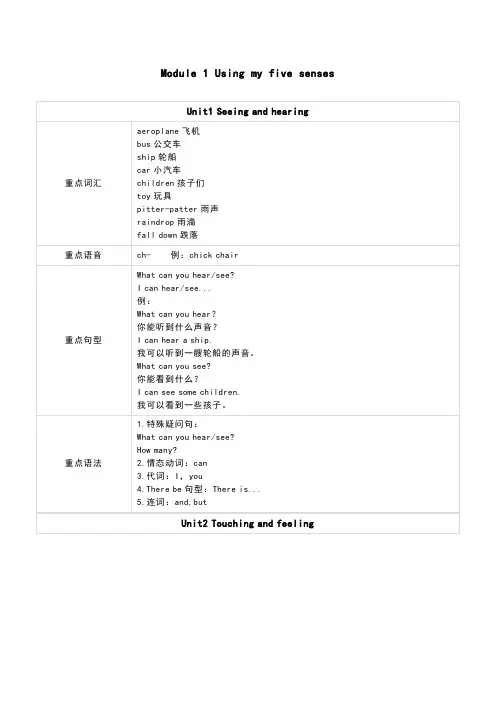
Do you like...? Yes,I do./No,I don’t. 例: Do you like elephants? 你喜欢大象吗? Yes,I do. 是的,我喜欢。 Do you like tigers? 你喜欢老虎吗? No,I don’t. 不,我不喜欢。
I have... My...is/are... 例:I have two eyes.My eyes are big. 我有两个眼睛。我的眼睛大。
Of course.当然。
1.动词 have:I have... 2.一般疑问句:Can you...? 3.Be 动词: These are... They are... 4.代 词 : my,me,myself,yourself
May I have a try? Sure. 我能试下吗?当然。
1.特殊疑问句: What is it? What’s this/that? What are these/those? 2.一般疑问句: Are they...? 3.Be 动词:It's/They're...
重点词汇 重点语音
重点句型
补充句型 重点语法
Module3 Things around us
Unit1 Shapes
circle 圆形 square 正方形 triangle 三角形 star 星形 rectangle 长方形
-ff 例:turn off take off
What shape is it? 它是什么形状的? It’s a circle. 它是一个圆形。
重点语法
1. 祈 使 句 : 动 词 原 形 开 头 例:Close your eyes./Smell this. 2. 特 殊 疑 问 句 : How does it smell/taste? What is it? 3.一般疑问句:Is it...? 4.Be 动词:It's...
上海牛津版英语3B语法总结+复习目标
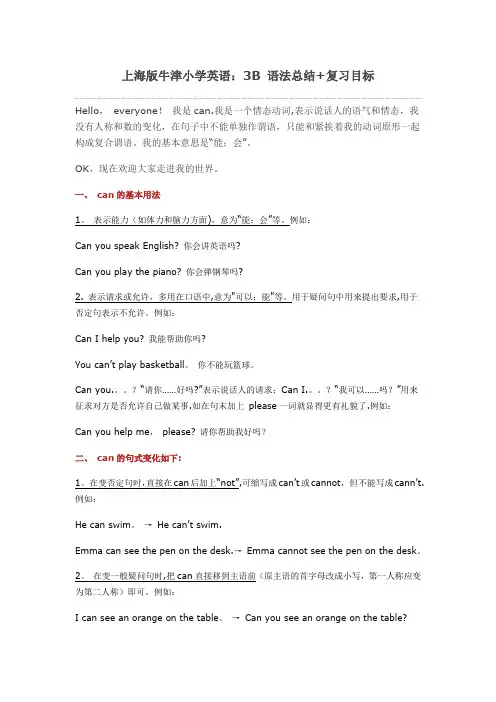
Hello,everyone!我是can.我是一个情态动词,表示说话人的语气和情态,我没有人称和数的变化,在句子中不能单独作谓语,只能和紧挨着我的动词原形一起构成复合谓语。
我的基本意思是“能;会”。
OK,现在欢迎大家走进我的世界。
一、can的基本用法1。
表示能力(如体力和脑力方面),意为“能;会”等。
例如:Can you speak English? 你会讲英语吗?Can you play the piano? 你会弹钢琴吗?2. 表示请求或允许,多用在口语中,意为"可以;能"等。
用于疑问句中用来提出要求,用于否定句表示不允许。
例如:Can I help you? 我能帮助你吗?You can’t play basketball。
你不能玩篮球。
Can you.。
?“请你……好吗?”表示说话人的请求;Can I.。
?“我可以……吗?”用来征求对方是否允许自己做某事.如在句末加上please一词就显得更有礼貌了.例如:Can you help me,please? 请你帮助我好吗?二、can的句式变化如下:1。
在变否定句时,直接在can后加上“not”,可缩写成can’t或cannot,但不能写成cann’t.例如:He can swim。
→He can’t swim.Emma can see the pen on the desk.→Emma cannot see the pen on the desk。
2。
在变一般疑问句时,把can直接移到主语前(原主语的首字母改成小写,第一人称应变为第二人称)即可。
例如:I can see an orange on the table。
→Can you see an orange on the table?其回答可用Yes, OK或Certainly等作肯定回答;用No或Sorry等作否定回答。
例如:—Can you look after my books, please?你能照看一下我的书吗?—OK。
上海小学牛津英语语法归纳总结
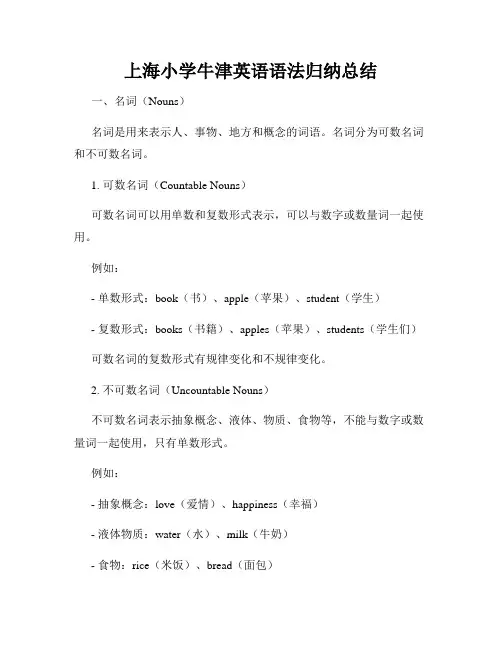
上海小学牛津英语语法归纳总结一、名词(Nouns)名词是用来表示人、事物、地方和概念的词语。
名词分为可数名词和不可数名词。
1. 可数名词(Countable Nouns)可数名词可以用单数和复数形式表示,可以与数字或数量词一起使用。
例如:- 单数形式:book(书)、apple(苹果)、student(学生)- 复数形式:books(书籍)、apples(苹果)、students(学生们)可数名词的复数形式有规律变化和不规律变化。
2. 不可数名词(Uncountable Nouns)不可数名词表示抽象概念、液体、物质、食物等,不能与数字或数量词一起使用,只有单数形式。
例如:- 抽象概念:love(爱情)、happiness(幸福)- 液体物质:water(水)、milk(牛奶)- 食物:rice(米饭)、bread(面包)不可数名词没有复数形式,不能直接与冠词a/an连用。
二、冠词(Articles)冠词用于限定名词的范围,分为定冠词和不定冠词。
1. 定冠词(Definite Article)定冠词是"the",用于特指已经提到的人或物,或者特指上下文中的某人或某物。
例如:- I saw a cat in the tree.(我看到树上有一只猫)- The cat was black.(那只猫是黑色的)2. 不定冠词(Indefinite Article)不定冠词有两种,分别是"a"和"an"。
用于泛指某一类人或物。
例如:- I have a dog.(我有一只狗)- She is an actress.(她是一名女演员)不定冠词"a"后面接辅音音素开头的词,"an"后面接元音音素开头的词。
三、形容词(Adjectives)形容词用来描述名词的特征和性质。
形容词通常位于名词之前。
- a big house(一个大房子)- a beautiful flower(一朵美丽的花)形容词可以用于比较级和最高级。
上海版牛津小学英语:5B-Module-4-语法-(1)动词过去式
上海版牛津小学英语:5B Module 4 语法(1)动词过去式_学习方法网
---------------------------------------前面我们已经学习过一般过去时的用法与结构了。
其中,最重要的构成部分就是动词的过去式,这一期,我们就来总结一下动词的过去式吧。
动词有规则动词和不规则动词之分。
规则动词的过去式都是以-ed结尾,而不规则动词的过去式是没有规则。
① 一般情况下,在动词原形后直接加ed。
如:wanted,played。
② 以不发音的字母e结尾的动词,直接加d。
如:hoped,lived。
③ 重读闭音节单词需双写最后一个辅音字母,再加ed。
如:stopped, shipped。
④ 以辅音字母+y结尾的动词变y为i,再加ed。
如:studied,worried。
⑤ 有些动词不符合上面的规则,需要特殊记忆。
如:am(is)-was, are-were, go-went, eat-ate, swim-swam, buy-bought, see-saw, lose-lost teach-taught, bring-brought, think-thought,
fall-fell, hurt-hurt, break-broke, win-won,考考你:
将下列动词变成过去式:write______ ring______
A. writed ringed
B. writed rang
C. wrote ringed
D. wrote rang
感谢阅读,欢迎大家下载使用!。
“牛津上海版”小学英语四年级(上)知识点大全
always 总是
日常表达 重点语法
语音
Merry Christmas!圣诞节快乐!
特殊疑问句: -How’s the weather in...?-It’s... What are they? Be 动词:It’s... There be 句型:There are... 情态动词:can 一般疑问句: A:Do you like...? B:Yes,I do./No,I don’t.
特殊疑问句:How do you feel? 表达感受的形容词: happy,sad,thirsty... Be 动词:I’m...We’re...He’s... A:How do you feel? B:I’m/We're happy,sad,thirsty...
名词所有格:名词+’s,例 Ginger’s There be 句型:There is/are... 一般疑问句:Are you...? 祈使句:动词原形开头,例 Come in, please.请进。
canteen 餐厅 computer lab 机房 office 办公室 gym 体育馆 behind 在...后面 in front of 在...前面 building 建筑物 lesson 课程 lunch 午餐 hall 礼堂;大厅 playground 操场 classroom 教室 library 图书馆 cupboard 橱柜 bookshelf 书架 desk and chair 桌椅 pencil case 铅笔盒 rubber 橡皮 pencil 铅笔 notebook 笔记本
Module4 The natural world
重点词汇
重点语法 语音
重点词汇
Unit1 A visit to a farm
上海版牛津小学英语:5B Module 1 语法(2)一般过去时
上海版牛津小学英语:5B Module 1 语法〔2〕一般过去时_学习方法网
---------------------------------------
通过Module One的学习,我们知道了很多过去时的表达。
这一期,我们就来总结一下一般过去时的结构。
一般过去时结构
① be动词〔is,am, are〕→ was/were
主语+ 谓语
② 实义动词→相应的动词过去式
①表示过去的事实或状态。
例:
He was very busy an hour ago. 他在过去的一小时非常忙碌。
I was eight years old last year. 我去年8岁。
②表示在过去某个时间内所作的事情,常和表示过去的时间状语连用。
例:
She bought many books yesterday . 昨天她买了很多书。
I played table tennis with my friend last Monday. 上周一我和一个朋友打了乒乓球。
表示过去的时间状语,有:yesterday,last week,last year,two days ago,...
考考你:
Lucy ___ her homework at home yesterday afternoon.
A. did
B. do
C. does
D. done
感谢阅读,欢送大家下载使用!。
上海牛津重点小学英语语法知识总结归纳
精心整理•一般情况下,直接加s?如:read-reads,swim-swims•以s,x,sh,ch,o结尾,加es?如:wash-washes,watch-watches,do-does•以辅音字母+y结尾,变y为i,再加es?如:study-studies,fly-flies•不规则变化如:have-has•4、一般现在时的句型转换:肯定句否定句一般疑问句及回答They watch TV everyday. They don’twatch TVeveryday.—Do they watch TVeveryday?—Yes,they do./No,they don’t.She watches TVShe doesn’t?watch—Does she watch TVeveryday?如:read-reading,drink-drinking,eat-eating,look-looking•以不发音的e结尾的动词,去掉e,再加ing如:write-writing,make-making,ride-riding,take-taking•以重读闭音节结尾,如末尾只有一个辅音字母,要双写这个字母,再加ing如:sit-sitting,swim-swimming,put-putting,run-running,stop-stopping,get-getting,2、构成:主语+动词的过去式+其他3、动词过去式的变化规则:肯定句否定句一般疑问句及回答—Did he watch TVyesterday? He watched TVyesterday. He didn’twatch TVyesterday.—Yes,he did./No,he didn’t.—Did they play gamesjustnow? They played gamesjustnow. They didn’tplay gamesjustnow.—Yes,they did./No,they didn’t. 一般将来时1、定义:表示将要发生的动作或存在的状态,以及打算、计划或准备某事。
- 1、下载文档前请自行甄别文档内容的完整性,平台不提供额外的编辑、内容补充、找答案等附加服务。
- 2、"仅部分预览"的文档,不可在线预览部分如存在完整性等问题,可反馈申请退款(可完整预览的文档不适用该条件!)。
- 3、如文档侵犯您的权益,请联系客服反馈,我们会尽快为您处理(人工客服工作时间:9:00-18:30)。
上海牛津小学英语语法知识总结一般现在时1、定义:表示经常发生或习惯性的动作、状态。
句中通常有usually,often,every day,sometimes,always,at weekends,on Sundays等表示经常性时间的短语。
2、构成:1)当谓语是b e动词时,一般现在时的构成:主语+be动词+其他如:I am a student. He is Jim’s fathe r. They are from Japan.2)当谓语是行为动词时,一般现在时的构成:①主语(非第三人称单数)+动词原形+其他如:I often watch TV at the weekends.Mr Green and Mrs Green like collecting stamps.②主语(第三人称单数)+动词的第三人称单数形式+其他如:Jim usually visits his grandparents on Sundays.She sometimes goes to the park with her mother.3、动词三单形式的变化规则:①如:read-reads,swim-swims②如:wash-washes,watch-watches,do-does③如:study-studies,fly-flies④如:have-has4、一般现在时的句型转换:现在进行时1、定义:表示现在或现阶段正在进行或发生的动作。
句中常有now ,look ,listen 等词。
如:I am washing clothes now. Look! Liu Tao is climbing the tree.Listen! Jane is singing in the music room.2、构成:be 动词(am/is/are )+ 动词现在分词(V-ing )3、动词现在分词构成:① 如:read-reading ,drink-drinking ,eat-eating ,look-looking ② 如:write-writing ,make-making ,ride-riding ,take-taking③ 如:sit-sitting ,swim-swimming ,put-putting ,run-running ,stop-stopping ,get-getting ,begin-beginning ,jog-jogging ,forget-forgetting4、动名词其实就是动词的现在分词,它既有名词性质(可作主语),又有动词性质(可带宾语)。
如:Asking the wayMy hobby is collecting stamps.He is good at skating.5、现在进行时的句型转换:一般过去时1、定义:表示过去某个时间里发生的动作或存在的状态。
常和表示过去的时间状语连用,如:a moment ago,just now,yesterday,last week,this morning等。
如:My brother often went to school by bike last term.The watch was beside the diary a moment ago.I watched the moon and ate the moon cakes last Mid-Autumn Festival.Jim went to the supermarket yesterday.2、构成:主语+动词的过去式+其他3、动词过去式的变化规则:①如:play-played,listen-listened,look-looked②如:live-lived ,like-liked ,taste-tasted ③如:study-studied ,carry-carried ,cry-cried④如:stop-stopped ,plan-planned ⑤ 如:am/is-was are-were have/has-had do-did go-went sit-sat tell-told see-saw get-got make-madegive-gave read-read buy-bought come-came draw-dreweat-ate fly-flew meet-met put-put run-ransay-said sing-sang swim-swam take-took4、一般过去时的句型转换一般将来时1、定义:表示将要发生的动作或存在的状态,以及打算、计划或准备某事。
句中一般含有表示将来的时间状语,如:tomorrow morning,next week,this afternoon等表示将来的时间状语。
2、构成:①be gong to +动词原形如:I am going to see a Beijing opera tomorrow.We are going to meet at bus stop at half past ten.Dad and I are going to see a Beijing opera this afternoon.②will +动词原形如:They will go swimming this afternoon.3、be going to 和will 区别:① be going to表示经过事先安排、打算或决定要做的事情,基本上一定会发生;will则表示有可能去做,但不一定发生,也常表示说话人的临时决定。
如:I am going to take part in a party this evening.They are cleaning the libra ry now. I’ll go and join them.②be going to表示近期或眼下就要发生的事情;will表示的将来时间则较远一些。
如:He is going to write a letter tomorrow. I will meet her one day.③ be going to还可以用来表示有迹象表明某件事将要发生,常用于天气等自然现象。
如:Look! It’s going to rain.4、一般将来时句型转换:句法1、陈述句说明事实或陈述说话人观点的句子。
基本结构:主语+谓语+其他1)肯定陈述句We all like pandas very much.2)否定陈述句He doesn’t do house work at weekends3)肯定陈述句改否定陈述句①一般是在b e动词或情态动词后加not。
Mary was at school yesterday. —> Mary was not at school yesterday.I can make a model plane. —>I can not make a model plane.②不含be动词或情态动词的,行为动词前要用助动词的否定式(don’t,doesn’t,didn’t),后面跟动词的原形。
He likes drawing pictures.—>He doesn’t like drawi ng pictures.I went to the park yesterday. —>I didn’t go to the park yeste rday.4)陈述句改一般疑问句①有be动词或情态动词的,把be动词或情态动词提前。
Mary was at school yesterday. —> Was Mary at school yesterday?I can make a model plane. —> Can you make a model plane?②不含be动词或情态动词的句子,借助助动词开头,动词还原成原形。
He likes drawing pictures.—>Does he like drawing pictures.I went to the park yesterday. —>Did you go to the park yesterday?2、疑问句用来提出问题,询问情况的句子,末尾用问号。
1)一般疑问句:一般疑问句常用来询问一件事是否属实,通常以be动词,助动词或情态动词开头,用yes或no来回答,因此又叫是非疑问句,通常读升调。
—Is Mr Green from the UK? —Yes,he is. / No,he isn’t.—Do you have any hobbies? —Yes,I do. / No,I don’t.—Can you play the guitar? —Yes,I can. / No,I can’t.2)特殊疑问句:以特殊疑问词引导,要求回答具体问题,不能用yes或no来回答。
—How do you go to work every day? —I go to work by car.3)选择疑问句:提供两种或两种以上情况,让对方选择,往往用or连接。
—Would you like some tea or coffee? —Some coffee, please.4)反意疑问句:反意疑问句是由陈述句和附在其后的附加疑问句组成。
—It’s a fine day, isn’t it? — Yes ,it is.3、祈使句表示请求或命令别人做某事或不做某事。
1)用于第二人称,通常省略you。
①肯定祈使句:Open the door, please.②否定祈使句:Don’t be late again.2)用于第一人称和第三人称,通常以let(let后跟宾格)或shall开头。
Let me have a look. Let’s play a game now. Let him go home now.Shall we meet at one thirty in front of the Garden Theatre?4、感叹句表达喜怒哀乐等强烈感情,句尾常用感叹号(!),语气用降调。
1)what + 名词或名词性短语What a big garden (it is)!What an interesting storybook (it is) !What lovely weather (it is)!What pretty girls (they are)!2)how +形容词或副词+主语+动词How nice!How beautiful the flowers are!How tall Yao Ming is!5、there be 句型表示在某地有某人或某物。
